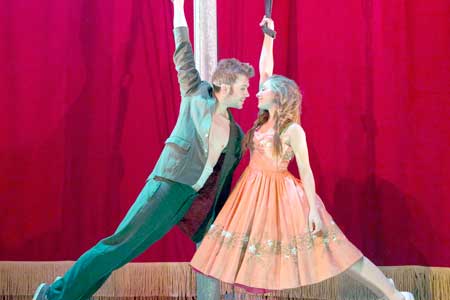Play
Directed and adapted by Emma Rice
Written by Carl Grose and Anna Maria Murphy
Produced by Kneehigh
Composer: Stu Barker; Designer: Bill Mitchell
ArtsEmerson
Cutler Majestic Theater
Theater District, Boston, MA
March 5-15, 2015
With Kirsty Woodward (Whiatehands), Dominic Marsh (Tristan), Stuart Goodwin (King Mark), Damon Daunno (Frocin), Hannah Vassallo (Yseult), Niall Ashdown (Morholt/Branigan)
Lovespotters, Brutes and Animators: Robert Luckay, Tom Jackson Greaves; Musicians: Lizzy Westcott, Justin Radform, Pat Moran, James Gow

by John Duncan
The myth of Tristan and Iseult, inspired by Celtic legend, came into prominence in twelfth century France. The story, further adapted by Gottfried von Strassburg in the early thirteenth century in Middle-High German, was taken up and reconceived by Richard Wagner as the subject of his great opera, Tristan und Isolde (1859).
In this rendition by Kneehigh, Frenchman Tristan is sent by King Mark of Cornwall, England to Ireland to get Iseult so he can marry her. On the way back to Cornwall from Ireland, Tristan and Iseult fall madly in love and have a tryst (so to speak). On arrival, Iseult still marries Mark and tries to cover up her lack of maidenhood by enlisting her servant as a stand-in. It doesn’t all work out so well in the end, but one thing is clear – that Tristan and Iseult continue to have a serious thing for one another, finally acknowledged in death.
Despite its heavy story and over-the-top romantic antecedent in Wagner’s great opera, this is a real entertainment by an offbeat group. Somehow they manage to tell the tale pretty well while goofing off in all sorts of ways. But the goofing – whether it’s with the audience blowing up and releasing balloons, or doing one sort of gymnastic trick or another or just dancing and bopping around – is very engaging. It all seems to ease up the audience to take in the sobriety of the story when it is finally laid out.
The only point at which the story gets really sober is at the very end and it is quite remarkable that after this fun-fest, the company manages to pull it off seriously and dramatically. At that point, enhanced by Wagner’s music, the procession after the final tragedy is quite intense and moving.

Hannah Vassallo as Yseult
in Kneehigh’s “Tristan and Iseult”
at ArtsEmerson
Photo: Richard Termine
This wonderful combination of drama, accessibility and entertainment all seems to be done within the spirit of the traditional bands of roving players that emerged prominently during the medieval era. Rousing audiences with direct appeal, they cultivated entertainment of one sort or another, energized the crowd, and then presented a serious play in between the cracks.
It is small wonder to hear that Emma Rice, the capable and visionary director of Tristan and Yseult was inspired by the English group, The Medieval Players, who, interestingly, were themselves inspired by our very own Bread and Puppet Theater.
There is a band that plays fairly continuously throughout, and the music, and the singing done by one or another of the actors at various points, is very good.
There is a lot of stagecraft choreography and gimmickry throughout that also really works. People are hoisted and swung on dangling ropes or raised on platforms. One of the more serious gags involves throwing real, sharp knives into the stage, then seeming to have them in hand during fight scenes, quite effectively unsettling.
The neon epigram posted onstage names “The Club of the Unloved,” rather than those passionately engaged in love, and there’s a kind of expressed sympathy for the romantic throwaways in this traditional passion-fest. The heat between the two lovers seems real, but there’s also a big nod to those who don’t quite get what they need.
This production falls well within the bounds of the appearance of new, easygoing but artful interpretations of classic stories, myths and plays that now are more theatrically popular than ever. This one manages, unlike some of them, to tell its traditional story quite well while making a rousing cabaret scene out of the whole experience.
Because of the entertaining shenanigans there’s not enough space to convey great dramatic complexity, but, as an effectively intense story told within the boundaries of a great, sometimes silly, romp, it works very well, making for an exceedingly good time and for a fine medieval-style telling of this medieval tale in a totally cool, contemporary idiom.
– BADMan
Leave a Reply